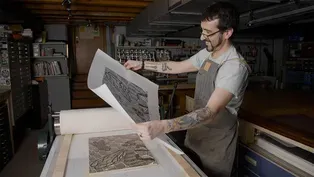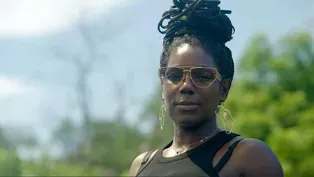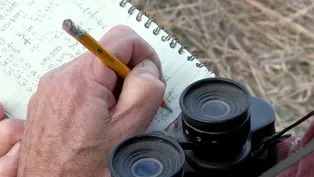
Rib Mountain
Clip: Season 10 Episode 8 | 4m 31sVideo has Closed Captions
Visiting Rib Mountain, Jill Sisson Quinn teaches her son about our place in the universe.
A Mother’s Lesson From Rib Mountain’ is an animated rendition of author Jill Sisson Quinn’s desire to teach her four-year-old son something about our existence in the Universe while hiking at Rib Mountain in Wisconsin. Her narrative weaves an intriguing thread through a variety of sciences including geology, biology, ecology, sociology, and astrophysics.
Problems with Closed Captions? Closed Captioning Feedback
Problems with Closed Captions? Closed Captioning Feedback
Wisconsin Life is a local public television program presented by PBS Wisconsin
Funding for Wisconsin Life is provided by the Wooden Nickel Fund, Mary and Lowell Peterson, A.C.V. and Mary Elston Family, Obrodovich Family Foundation, Stanley J. Cottrill Fund, Alliant Energy, UW...

Rib Mountain
Clip: Season 10 Episode 8 | 4m 31sVideo has Closed Captions
A Mother’s Lesson From Rib Mountain’ is an animated rendition of author Jill Sisson Quinn’s desire to teach her four-year-old son something about our existence in the Universe while hiking at Rib Mountain in Wisconsin. Her narrative weaves an intriguing thread through a variety of sciences including geology, biology, ecology, sociology, and astrophysics.
Problems with Closed Captions? Closed Captioning Feedback
How to Watch Wisconsin Life
Wisconsin Life is available to stream on pbs.org and the free PBS App, available on iPhone, Apple TV, Android TV, Android smartphones, Amazon Fire TV, Amazon Fire Tablet, Roku, Samsung Smart TV, and Vizio.
Providing Support for PBS.org
Learn Moreabout PBS online sponsorship[ethereal music, birds chirping] [footsteps crunching] - Mother: I want my 4-year-old son to climb a mountain; not so easy in Wisconsin.
[spinning sunglasses make 'skeedaddle' sound] Long ago, mountains as high as the Rockies covered the area which is now our state.
But today, I'll have to settle for 1,942-foot Rib Mountain.
It's a remnant of that ancient Rocky-sized range, buried by sediment, then revealed through erosion.
I'm not concerned by the modest elevation because this mountain sports something more impressive: its age.
Rib Mountain contains some of the oldest rock in the world.
At 1.7 billion years old, these rocks have been around for more than a third of the Earth's existence.
We rub our hands across the striations on the side of a boulder, made by waves when the now quartzite was a river valley or ocean bottom.
"Long ago, this rock used to be sand," I say.
I am awed by this evidence of the rock's previous forms.
First sand, then sandstone, now quartzite.
I tell my son to think about the ripples the ocean makes along the seashore.
He gets it.
Looking around the heavily wooded mountaintop and responding, "There must not have been any trees here then."
Next, I tell him the rock's age, knowing full well his understanding of such things still has a long way to go.
His own number of fingers and toes as yet a daily discovery.
This window of not-yet-complete awareness of his own form might be a good time, I figure, to convince him of what we, like the rock, really are-- "The rock is old," I say to my son.
"But you and the rock are really the same age, around 13.8 billion years old.
The atoms in your body and the atoms in the rock made just after the birth of the universe and in exploding stars.
You are stardust."
'Stardust,' he repeats, and smiles.
He's heard me say it before.
I want my son to take the long view, to think like a mountain, even when he is not on the mountain, and not only about the Earth, as Aldo Leopold imparted, but about himself.
We should not get mired in how one strand of identity formulates us.
But consider all the strands: the food we eat, the microbes we host, where we grow up, and the DNA we inherit.
No more or less important than the atoms that make up all this stuff.
I don't deny what we appreciate in the rock, its consistency of form, being itself, over such an unimaginable period of time.
It's old; it's something; it has exactly the sort of permanence we ourselves desire.
I come to the mountain today not only in a parent's feeble attempt to make my son seem immortal but to help him better navigate life's journey; it's hard facts, as well as its uncertainties.
One hundred years; the most humans can expect is not much.
Yet over that 100 years, our solid seeming body is in constant change; individual cells live from a few days to at most 10 years, continuously rebuilt from materials from our immediate environment.
We are not sandstone then quartzite for a billion years or even human for one hundred.
We are sea, land, and sky all in one lifetime.
[object whooshing through the cosmos]] [gentle acoustic guitar]
Video has Closed Captions
Clip: S10 Ep8 | 4m 54s | Baraboo artist Tim Znidarsich demonstrates the intensive process of printmaking. (4m 54s)
Video has Closed Captions
Clip: S10 Ep8 | 5m 19s | A look into the transformative work of Urban Triage and its founder, Brandi Grayson. (5m 19s)
Video has Closed Captions
Clip: S10 Ep8 | 5m 56s | Trio of friends mark tradition with four decades of crane counting. (5m 56s)
Providing Support for PBS.org
Learn Moreabout PBS online sponsorshipSupport for PBS provided by:
Wisconsin Life is a local public television program presented by PBS Wisconsin
Funding for Wisconsin Life is provided by the Wooden Nickel Fund, Mary and Lowell Peterson, A.C.V. and Mary Elston Family, Obrodovich Family Foundation, Stanley J. Cottrill Fund, Alliant Energy, UW...














